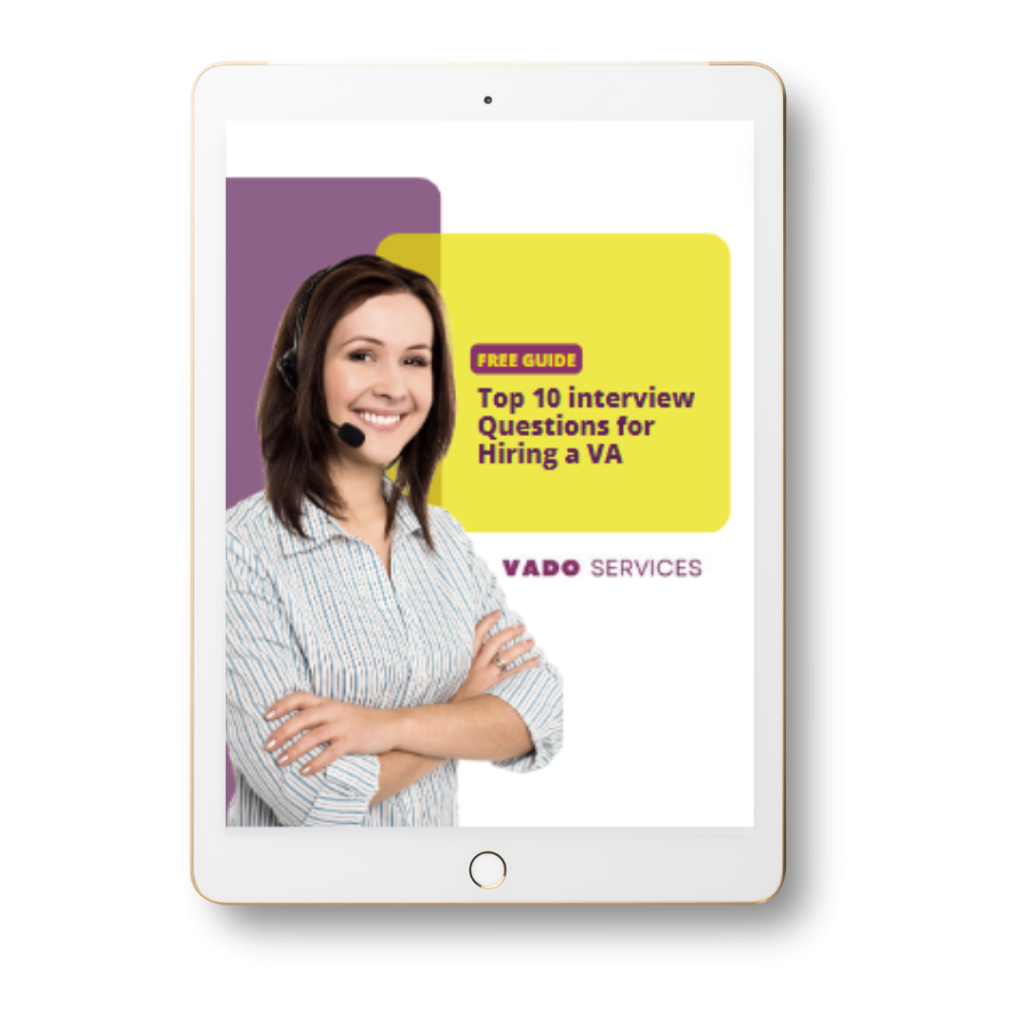Understanding the ROI on virtual assistants in a travel agency is challenging but essential. When you learn to measure your VA performance metrics, you can uncover valuable insights to drive your agency’s success.
Let’s explore how these digital allies can lighten the load and boost your bottom line.
How to Track the Performance of Your Virtual Assistant
Tracking your VA performance metrics can help you assess their impact on your travel agency’s operations and determine the return on investment (ROI) in remote support. This is key to measuring remote team results, apart from the ROI on virtual assistants themselves.
Start by establishing clear performance metrics aligned with your travel agency’s goals. These metrics could include tasks completed per hour, customer satisfaction ratings on interactions handled by the VA, response time to inquiries, or even cost savings achieved through their efforts. By setting specific benchmarks, you can objectively evaluate the effectiveness of your VA in supporting your travel agency’s operations.
Keep in mind that measuring remote team results goes beyond just monitoring tasks completed. It involves analyzing the quality of work, the impact on overall productivity, and the level of customer satisfaction achieved through your VA’s assistance. Utilizing tools like time-tracking software, project management platforms, and regular performance evaluations can provide you with the data needed to evaluate your VA’s performance accurately.
List the Tasks to Delegate
When considering tasks to delegate, it’s essential to identify common responsibilities typically handled by travel agents that lend themselves well to remote support. Tasks such as booking flights, responding to emails, handling client inquiries, conducting research, and updating travel itineraries are ideal for delegation to virtual assistants.
Booking flights, for example, is a task that often requires repetitive steps and can be time-consuming for travel agents. Delegating this task to a virtual assistant allows agents to focus on more complex aspects of trip planning, such as creating unique itineraries tailored to each client’s preferences.
VA’s are also hired for responding to emails and client inquiries. This way, they free up agents to engage in personal interactions with clients or work on strategic business development.
Researching destinations, accommodations, and activities is another area where virtual assistants can provide valuable support. They can gather information, compare options, and present recommendations to agents, who can then use this data to advise clients effectively.
If you find that it’s easier, you can list the necessary steps that take a new client from inquiry to the final stage of your sales process–and we don’t mean “booked”! The client then travels, and you maintain a relationship with them for repeat business and convert them into raving fans that send you referrals consistently.
List these tasks for delegation and optimize your travel agency’s workflow, reduce operational costs, and enhance the overall customer experience.
Estimate the Time It Takes to Complete Each Task
By estimating the time it takes to accomplish specific tasks, we can better grasp the potential benefits of integrating virtual assistants into your workflow.
On average, manually booking a flight for a customer can take anywhere from 15 to 30 minutes, depending on the complexity of the itinerary, availability of seats, and airline policies.
Responding to emails, addressing concerns, and providing information on travel packages can take, say, 10 to 20 minutes per inquiry. This time can vary based on the complexity of the query and the level of detail required in the response.
Last but not least, modifying existing travel itineraries for clients, including changes to flights, accommodations, or activities, typically requires 10 to 15 minutes per update. This task involves coordinating with various service providers and ensuring the accuracy of the information provided to the traveler.
If your VA can do these tasks within the estimated time, it can significantly streamline your operations and free up valuable resources for your travel agency.
Track VA Time Using Software
Advanced time-tracking software allows you to monitor the activities of virtual assistants to ensure accurate assessment of VA performance metrics.
Tools like Toggl, Clockify, and Hubstaff offer various features to track VA tasks effectively. These platforms let you assign specific projects, set time expectations, and monitor progress in real-time.
Tracking VA time using software is crucial for maintaining transparency and accountability. Moreover, by accurately recording the time spent on different tasks, you can identify areas of improvement and streamline workflows. Consistency in tracking VA work is key to understanding their performance levels and making data-driven decisions.
Moreover, these software solutions provide detailed insights into how VAs allocate their time throughout the day. This data can help you identify any inefficiencies, prioritize tasks more effectively, and ultimately enhance overall productivity. If you have a clear overview of where time is being allocated, you can better assess the ROI of virtual assistants.
Measure Time Saved by Delegating
After efficiently tracking VA time using software, the next step is to measure the time saved by delegating tasks to VAs. This way, you can quantify the impact on overall productivity and agency capacity, pointing out the benefits of outsourcing tasks.
Here are three key ways to achieve this:
- Client Interaction Time: Analyze the time spent on client interactions and customer service tasks.
- Task Log Analysis: Keep a detailed log of tasks that were previously handled by in-house staff but have now been delegated to virtual assistants. Track the time it takes for VAs to complete these tasks compared to the time it would have taken your team. Calculate the cumulative time saved over a specific period to understand the efficiency gains.
- Productivity Tracking: Monitor the productivity levels of your team before and after delegating tasks to virtual assistants. Measure the increase in output and the time freed up for core activities. This data will provide a clear picture of the time saved by leveraging VAs for routine tasks.
Calculate Net Time Savings
When determining the net time savings, it’s essential to account for the time spent overseeing and instructing the VA to ensure an accurate representation of the overall efficiency gain.
For instance, if managing and training a virtual assistant consumes 5 hours a week but results in saving 15 hours of work that would have otherwise been done by you, the net time savings amounts to 10 hours per week. This 10-hour difference is where the true benefit lies in terms of time efficiency.
To translate this time savings into a tangible cost-saving measure, multiply the 10 hours by your hourly rate. If your hourly rate is $50, the weekly cost savings from delegating tasks to the VA would be $500. This calculation showcases the monetary value of the time saved by integrating VAs into your travel agency’s operations.
Calculate VA’s Cost
VAs can have a financial impact on your travel agency and you need to evaluate it. Calculate their cost based on the total time they dedicated to completing tasks at their hourly rate.
Begin by comparing the total time your virtual assistant spent on completing the task(s) you assigned. This provides a clear picture of the effort invested.
After that, determine the hourly rate of your VA and multiply it by the total time spent on tasks. This will give you the cost incurred for their services based on their hourly wage.
Once you have the calculated cost, compare it to the time saved by delegating tasks to your VA. Highlight the return not only in monetary terms but also in the hours you were able to reallocate to more critical aspects of your travel agency.
Compare Costs
Let’s keep analyzing the financial impact of virtual assistants by calculating their costs. At some point in this process, you must compare the expenses incurred when handling tasks independently versus delegating them to a VA.
When assessing costs, consider not just the direct financial implications, but also the opportunity costs associated with time spent on tasks that could be outsourced.
To compare costs effectively, subtract your own cost, based on your hourly rate, for completing a specific task from the VA’s cost to handle the same task. This calculation provides a clear picture of the cost savings achieved by delegating responsibilities to a virtual assistant.
About VADO Services
At VADO Services, we provide specialized virtual assistant services to help travel agencies streamline operations and maximize ROI. As a business owner, you understand the challenges of managing a growing agency, especially when it comes to handling time-consuming tasks like data entry, social media management, and administrative duties. Instead of hiring full-time employees, consider the advantages of hiring virtual assistants who can support your business goals without the added burden of high overhead costs and office space expenses.
Using virtual assistant services helps reduce costs while maintaining productivity. VAs offer flexible solutions, working part-time or full-time, without the long-term financial commitment or overhead costs associated with traditional hires. With the freedom to scale support as needed, you only pay for the work required, enabling you to maximize your resources and invest in what matters most.
Let VADO Services help you hire a virtual assistant that will contribute to your growth while keeping costs in check. Contact us now!



